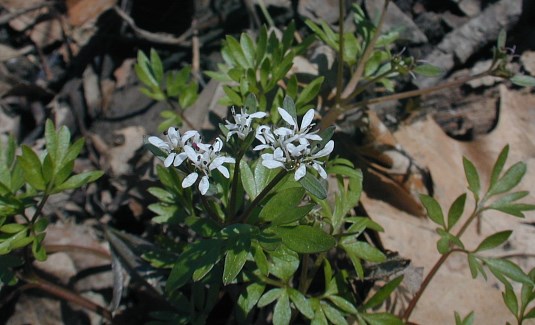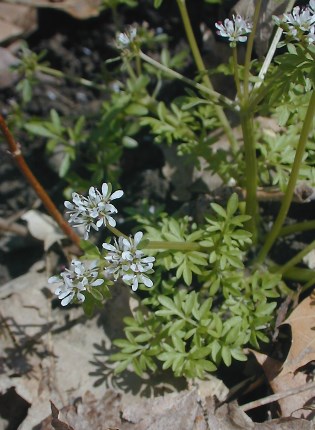Description: This perennial wildflower is 3-10" tall, consisting of one or more stems with alternate leaves and compound umbels of flowers. The light green to reddish brown stems are stout, longitudinal ridged, and glabrous; sometimes they are erect, but more often sprawl across the ground. The leaves are up to 5" long and 3" across; they are ternately compound (typically divided into 3 leaflets). Each leaflet is irregularly cleft into about 3 narrow lobes; these lobes are oblong, elliptic-oblong, or narrowly oblanceolate and their margins lack teeth. The blades of the leaves (i.e., their leaflets) are light to medium green and glabrous, while their long petioles are sheathed at the base.

The stems
terminate in compound umbels of white flowers. Each compound umbel
consists of 1-4 umbellets, while each umbellet has 1-6 flowers. The
flowers of each umbellet are closely bunched together because their
pedicels are quite short. At the base of each umbellet, there is a
small leafy bract. Each flower is about ¼" across, consisting of 5
narrow white petals, 5 stamens, a divided white style, and no sepals.
The anthers of the stamens are initially dark red, but they soon turn
black. The blooming period occurs from early to mid-spring and lasts
about 1 month. Each flower is replaced by a slightly flattened globoid
fruit (a schizocarp) that contains a single seed. The root system
consists of a corm with fibrous roots. This wildflower reproduces by
reseeding itself. Occasionally, it forms loose colonies of plants.
Cultivation:
Some dappled sunlight is required during the spring, otherwise shade is
tolerated. Moist to mesic conditions and a rich loamy soil with some
rotting organic matter are preferred. Most vegetative growth and
development occurs during the spring.
spring.
Range & Habitat:
The native Harbinger-of-Spring has a scattered distribution throughout
most of
Illinois, but it is absent from the NW section of the state (see Distribution
Map).
It is occasional in some woodlands, but mysteriously
absent from many others. Habitats include rich mesic woodlands with
deciduous trees, wooded areas at the base of bluffs, rocky bluffs,
wooded bottomland of rocky canyons, gentle wooded slopes along rivers,
and areas along woodland paths. This wildflower is normally found in
high quality deciduous woodlands.
Faunal Associations:
The flowers attract primarily small to medium-size bees and
miscellaneous flies. Bee visitors include Little Carpenter bees
(Ceratina spp.), Mason bees (Osmia spp.), Andrenid bees (Andrena spp.),
and Halictid bees (Lasioglossum spp., Halictus spp., etc.). Fly
visitors include Calliphorid flies, Anthomyiid flies, Frit flies
(Chloropidae), Lance flies (Lonchaeidae), and flower flies (Syrphidae).
These insects seek primarily nectar from the flowers.
Photographic Location:
A wooded area at the base of a bluff in Kickapoo State Park, Vermilion
County, Illinois. This location is not far from an abandoned coal mine.
Comments:
This is one of the earliest wildflowers to bloom in our deciduous
woodlands. Because of its small flowers and low growth habit, it is
rather easy to overlook. Also, when observed from a distance,
Harbinger-of-Spring can be confused with other wildflowers with small
white flowers. Another common name is 'Pepper-and-Salt Plant,' which
refers to the anthers of the flowers (after they have become black) and
the bright white petals. This wildflower is fairly distinctive because
of its period of early bloom, stout stems, oddly colored anthers, and
tight umbellets of flowers with narrow white petals.